Critical Review: Assessing PHEVs Using Electromagnetic Brakes
VerifiedAdded on 2023/05/30
|12
|2867
|434
Report
AI Summary
This report presents a critical review of electromagnetic brakes in Plug-in Hybrid Electric Vehicles (PHEVs), drawing on multiple research papers to analyze various aspects of these vehicles. The review covers cost analysis, comparing PHEVs to conventional cars and highlighting the impact of battery costs, energy consumption, repair, maintenance, and resale values. It also examines electromagnetic interference (EMI) from electric/hybrid vehicles, discussing different car types and assessing radiation levels. Furthermore, the report explores braking energy regeneration systems, detailing different methods and experimental results. Finally, it assesses magnetic field exposure in electric vehicles, comparing them to combustion engine vehicles and evaluating exposure levels. The review also touches on the dynamic coordinated shifting control of automated mechanical transmissions without a clutch in PHEVs and assesses the sustainability of electric vehicles as a personal mobility system, considering both economic viability and environmental friendliness.
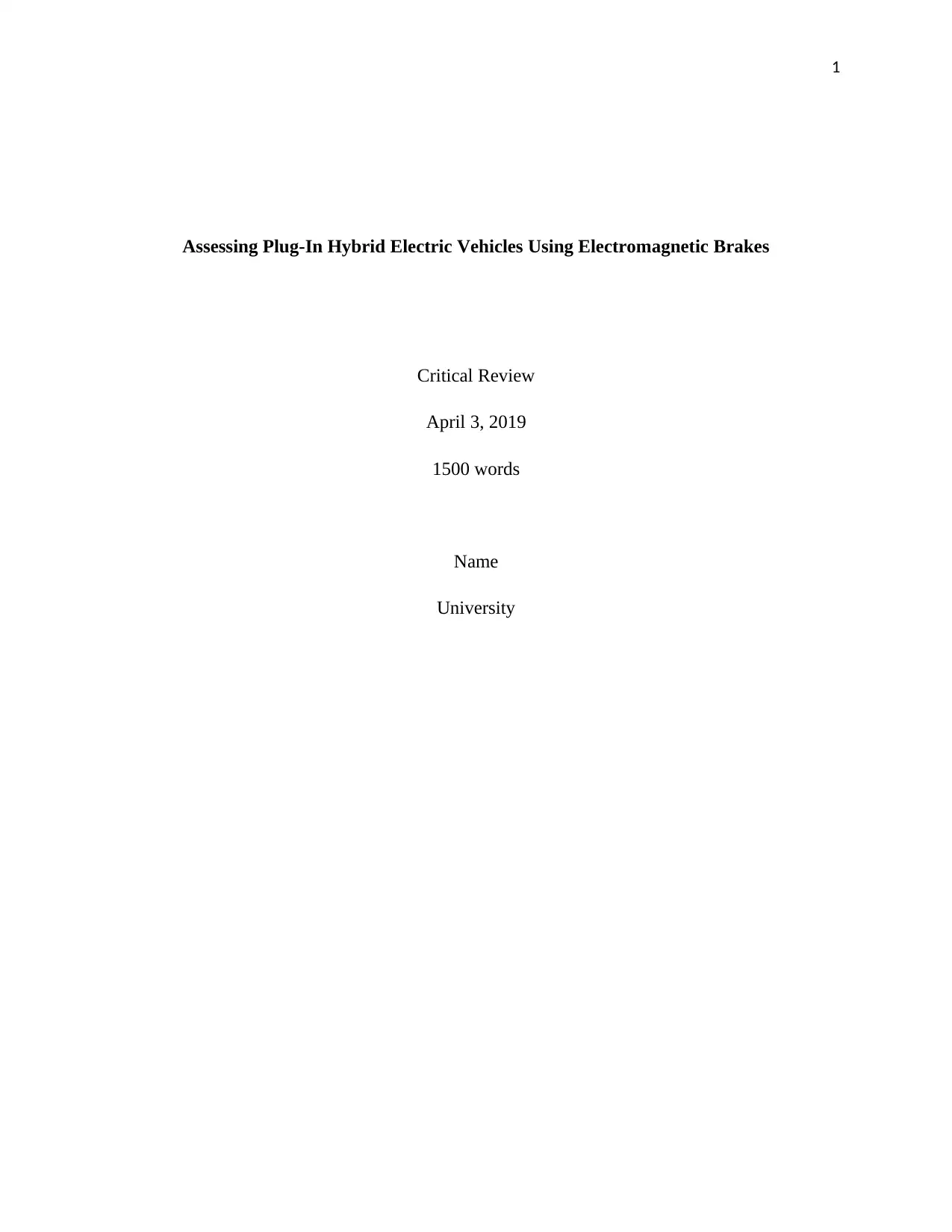
1
Assessing Plug-In Hybrid Electric Vehicles Using Electromagnetic Brakes
Critical Review
April 3, 2019
1500 words
Name
University
Assessing Plug-In Hybrid Electric Vehicles Using Electromagnetic Brakes
Critical Review
April 3, 2019
1500 words
Name
University
Paraphrase This Document
Need a fresh take? Get an instant paraphrase of this document with our AI Paraphraser
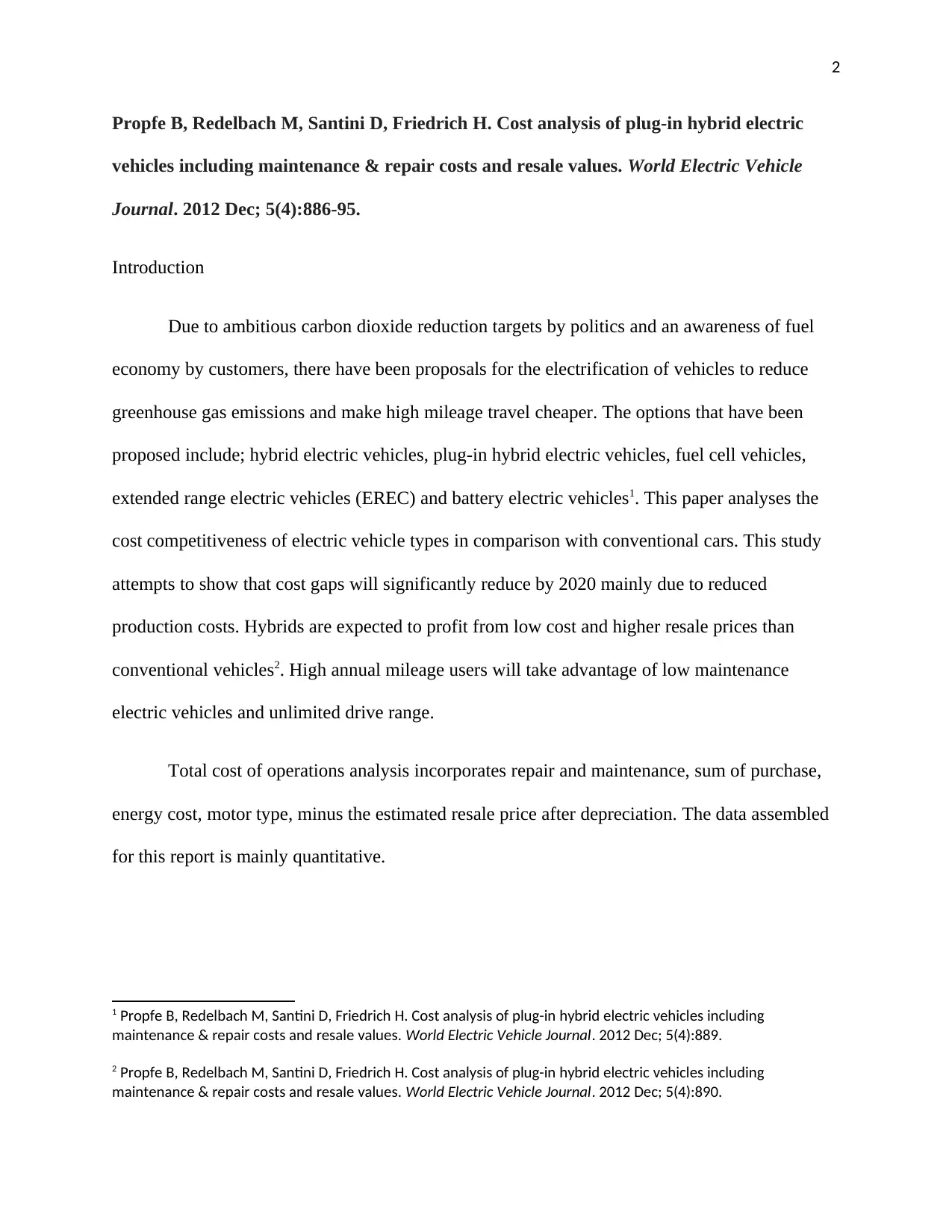
2
Propfe B, Redelbach M, Santini D, Friedrich H. Cost analysis of plug-in hybrid electric
vehicles including maintenance & repair costs and resale values. World Electric Vehicle
Journal. 2012 Dec; 5(4):886-95.
Introduction
Due to ambitious carbon dioxide reduction targets by politics and an awareness of fuel
economy by customers, there have been proposals for the electrification of vehicles to reduce
greenhouse gas emissions and make high mileage travel cheaper. The options that have been
proposed include; hybrid electric vehicles, plug-in hybrid electric vehicles, fuel cell vehicles,
extended range electric vehicles (EREC) and battery electric vehicles1. This paper analyses the
cost competitiveness of electric vehicle types in comparison with conventional cars. This study
attempts to show that cost gaps will significantly reduce by 2020 mainly due to reduced
production costs. Hybrids are expected to profit from low cost and higher resale prices than
conventional vehicles2. High annual mileage users will take advantage of low maintenance
electric vehicles and unlimited drive range.
Total cost of operations analysis incorporates repair and maintenance, sum of purchase,
energy cost, motor type, minus the estimated resale price after depreciation. The data assembled
for this report is mainly quantitative.
1 Propfe B, Redelbach M, Santini D, Friedrich H. Cost analysis of plug-in hybrid electric vehicles including
maintenance & repair costs and resale values. World Electric Vehicle Journal. 2012 Dec; 5(4):889.
2 Propfe B, Redelbach M, Santini D, Friedrich H. Cost analysis of plug-in hybrid electric vehicles including
maintenance & repair costs and resale values. World Electric Vehicle Journal. 2012 Dec; 5(4):890.
Propfe B, Redelbach M, Santini D, Friedrich H. Cost analysis of plug-in hybrid electric
vehicles including maintenance & repair costs and resale values. World Electric Vehicle
Journal. 2012 Dec; 5(4):886-95.
Introduction
Due to ambitious carbon dioxide reduction targets by politics and an awareness of fuel
economy by customers, there have been proposals for the electrification of vehicles to reduce
greenhouse gas emissions and make high mileage travel cheaper. The options that have been
proposed include; hybrid electric vehicles, plug-in hybrid electric vehicles, fuel cell vehicles,
extended range electric vehicles (EREC) and battery electric vehicles1. This paper analyses the
cost competitiveness of electric vehicle types in comparison with conventional cars. This study
attempts to show that cost gaps will significantly reduce by 2020 mainly due to reduced
production costs. Hybrids are expected to profit from low cost and higher resale prices than
conventional vehicles2. High annual mileage users will take advantage of low maintenance
electric vehicles and unlimited drive range.
Total cost of operations analysis incorporates repair and maintenance, sum of purchase,
energy cost, motor type, minus the estimated resale price after depreciation. The data assembled
for this report is mainly quantitative.
1 Propfe B, Redelbach M, Santini D, Friedrich H. Cost analysis of plug-in hybrid electric vehicles including
maintenance & repair costs and resale values. World Electric Vehicle Journal. 2012 Dec; 5(4):889.
2 Propfe B, Redelbach M, Santini D, Friedrich H. Cost analysis of plug-in hybrid electric vehicles including
maintenance & repair costs and resale values. World Electric Vehicle Journal. 2012 Dec; 5(4):890.
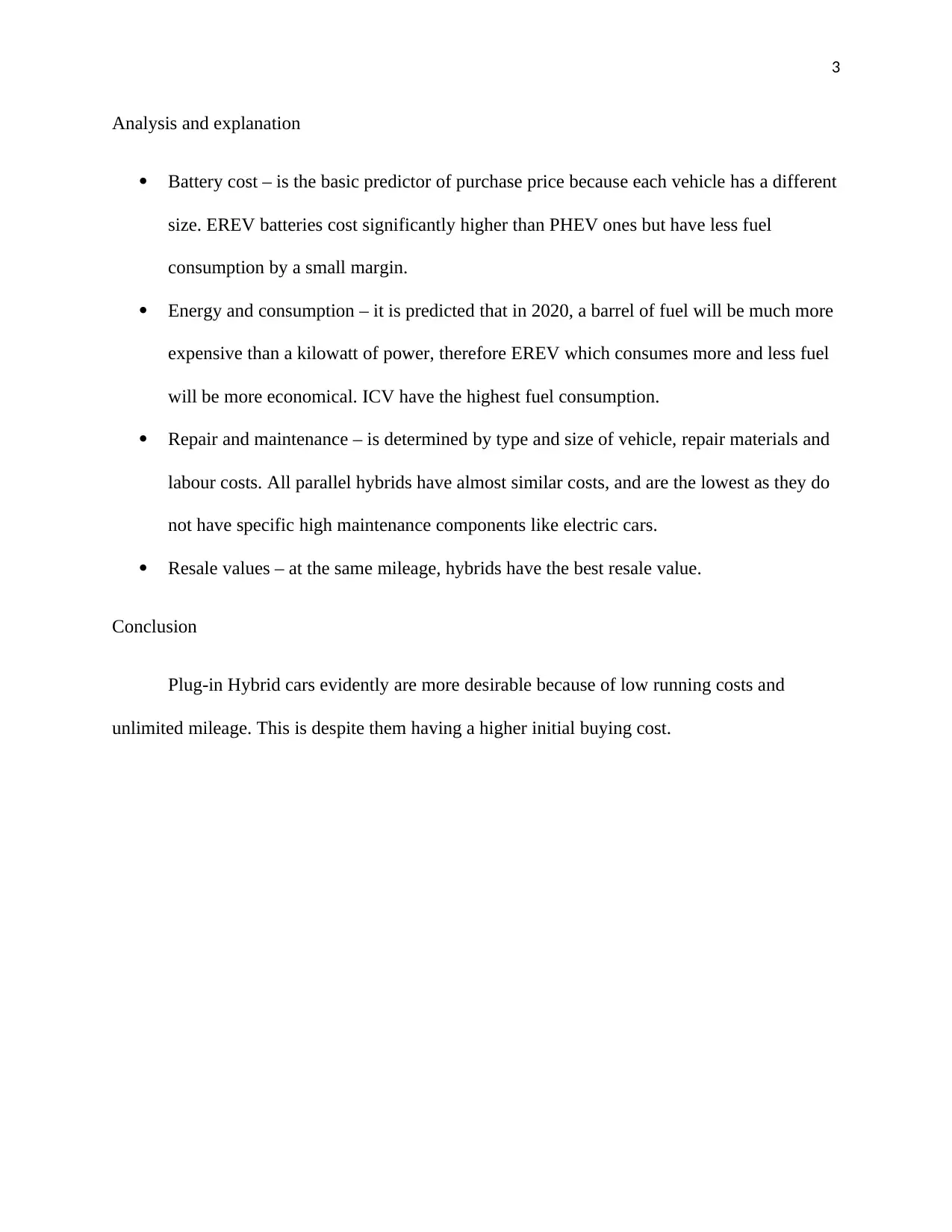
3
Analysis and explanation
Battery cost – is the basic predictor of purchase price because each vehicle has a different
size. EREV batteries cost significantly higher than PHEV ones but have less fuel
consumption by a small margin.
Energy and consumption – it is predicted that in 2020, a barrel of fuel will be much more
expensive than a kilowatt of power, therefore EREV which consumes more and less fuel
will be more economical. ICV have the highest fuel consumption.
Repair and maintenance – is determined by type and size of vehicle, repair materials and
labour costs. All parallel hybrids have almost similar costs, and are the lowest as they do
not have specific high maintenance components like electric cars.
Resale values – at the same mileage, hybrids have the best resale value.
Conclusion
Plug-in Hybrid cars evidently are more desirable because of low running costs and
unlimited mileage. This is despite them having a higher initial buying cost.
Analysis and explanation
Battery cost – is the basic predictor of purchase price because each vehicle has a different
size. EREV batteries cost significantly higher than PHEV ones but have less fuel
consumption by a small margin.
Energy and consumption – it is predicted that in 2020, a barrel of fuel will be much more
expensive than a kilowatt of power, therefore EREV which consumes more and less fuel
will be more economical. ICV have the highest fuel consumption.
Repair and maintenance – is determined by type and size of vehicle, repair materials and
labour costs. All parallel hybrids have almost similar costs, and are the lowest as they do
not have specific high maintenance components like electric cars.
Resale values – at the same mileage, hybrids have the best resale value.
Conclusion
Plug-in Hybrid cars evidently are more desirable because of low running costs and
unlimited mileage. This is despite them having a higher initial buying cost.
⊘ This is a preview!⊘
Do you want full access?
Subscribe today to unlock all pages.

Trusted by 1+ million students worldwide
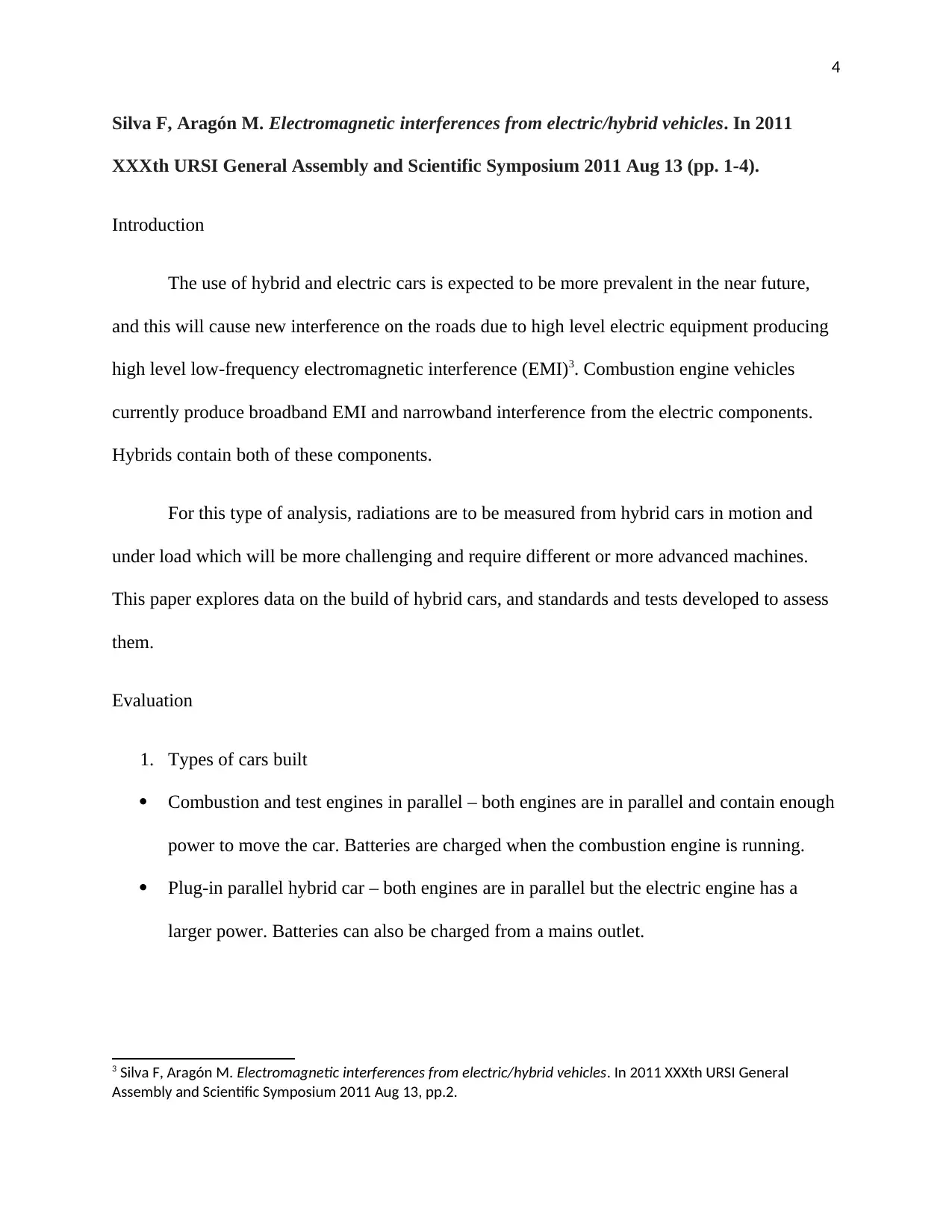
4
Silva F, Aragón M. Electromagnetic interferences from electric/hybrid vehicles. In 2011
XXXth URSI General Assembly and Scientific Symposium 2011 Aug 13 (pp. 1-4).
Introduction
The use of hybrid and electric cars is expected to be more prevalent in the near future,
and this will cause new interference on the roads due to high level electric equipment producing
high level low-frequency electromagnetic interference (EMI)3. Combustion engine vehicles
currently produce broadband EMI and narrowband interference from the electric components.
Hybrids contain both of these components.
For this type of analysis, radiations are to be measured from hybrid cars in motion and
under load which will be more challenging and require different or more advanced machines.
This paper explores data on the build of hybrid cars, and standards and tests developed to assess
them.
Evaluation
1. Types of cars built
Combustion and test engines in parallel – both engines are in parallel and contain enough
power to move the car. Batteries are charged when the combustion engine is running.
Plug-in parallel hybrid car – both engines are in parallel but the electric engine has a
larger power. Batteries can also be charged from a mains outlet.
3 Silva F, Aragón M. Electromagnetic interferences from electric/hybrid vehicles. In 2011 XXXth URSI General
Assembly and Scientific Symposium 2011 Aug 13, pp.2.
Silva F, Aragón M. Electromagnetic interferences from electric/hybrid vehicles. In 2011
XXXth URSI General Assembly and Scientific Symposium 2011 Aug 13 (pp. 1-4).
Introduction
The use of hybrid and electric cars is expected to be more prevalent in the near future,
and this will cause new interference on the roads due to high level electric equipment producing
high level low-frequency electromagnetic interference (EMI)3. Combustion engine vehicles
currently produce broadband EMI and narrowband interference from the electric components.
Hybrids contain both of these components.
For this type of analysis, radiations are to be measured from hybrid cars in motion and
under load which will be more challenging and require different or more advanced machines.
This paper explores data on the build of hybrid cars, and standards and tests developed to assess
them.
Evaluation
1. Types of cars built
Combustion and test engines in parallel – both engines are in parallel and contain enough
power to move the car. Batteries are charged when the combustion engine is running.
Plug-in parallel hybrid car – both engines are in parallel but the electric engine has a
larger power. Batteries can also be charged from a mains outlet.
3 Silva F, Aragón M. Electromagnetic interferences from electric/hybrid vehicles. In 2011 XXXth URSI General
Assembly and Scientific Symposium 2011 Aug 13, pp.2.
Paraphrase This Document
Need a fresh take? Get an instant paraphrase of this document with our AI Paraphraser
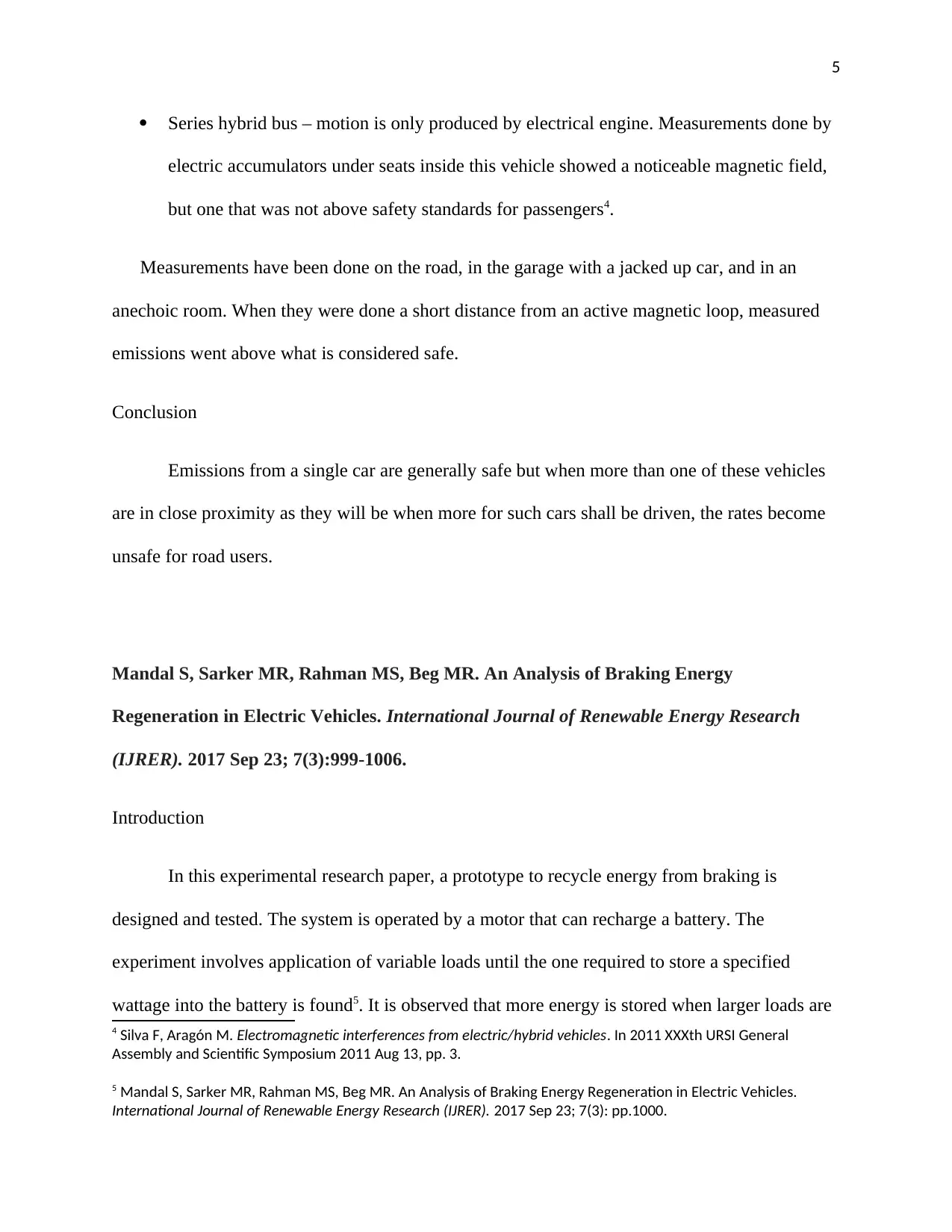
5
Series hybrid bus – motion is only produced by electrical engine. Measurements done by
electric accumulators under seats inside this vehicle showed a noticeable magnetic field,
but one that was not above safety standards for passengers4.
Measurements have been done on the road, in the garage with a jacked up car, and in an
anechoic room. When they were done a short distance from an active magnetic loop, measured
emissions went above what is considered safe.
Conclusion
Emissions from a single car are generally safe but when more than one of these vehicles
are in close proximity as they will be when more for such cars shall be driven, the rates become
unsafe for road users.
Mandal S, Sarker MR, Rahman MS, Beg MR. An Analysis of Braking Energy
Regeneration in Electric Vehicles. International Journal of Renewable Energy Research
(IJRER). 2017 Sep 23; 7(3):999-1006.
Introduction
In this experimental research paper, a prototype to recycle energy from braking is
designed and tested. The system is operated by a motor that can recharge a battery. The
experiment involves application of variable loads until the one required to store a specified
wattage into the battery is found5. It is observed that more energy is stored when larger loads are
4 Silva F, Aragón M. Electromagnetic interferences from electric/hybrid vehicles. In 2011 XXXth URSI General
Assembly and Scientific Symposium 2011 Aug 13, pp. 3.
5 Mandal S, Sarker MR, Rahman MS, Beg MR. An Analysis of Braking Energy Regeneration in Electric Vehicles.
International Journal of Renewable Energy Research (IJRER). 2017 Sep 23; 7(3): pp.1000.
Series hybrid bus – motion is only produced by electrical engine. Measurements done by
electric accumulators under seats inside this vehicle showed a noticeable magnetic field,
but one that was not above safety standards for passengers4.
Measurements have been done on the road, in the garage with a jacked up car, and in an
anechoic room. When they were done a short distance from an active magnetic loop, measured
emissions went above what is considered safe.
Conclusion
Emissions from a single car are generally safe but when more than one of these vehicles
are in close proximity as they will be when more for such cars shall be driven, the rates become
unsafe for road users.
Mandal S, Sarker MR, Rahman MS, Beg MR. An Analysis of Braking Energy
Regeneration in Electric Vehicles. International Journal of Renewable Energy Research
(IJRER). 2017 Sep 23; 7(3):999-1006.
Introduction
In this experimental research paper, a prototype to recycle energy from braking is
designed and tested. The system is operated by a motor that can recharge a battery. The
experiment involves application of variable loads until the one required to store a specified
wattage into the battery is found5. It is observed that more energy is stored when larger loads are
4 Silva F, Aragón M. Electromagnetic interferences from electric/hybrid vehicles. In 2011 XXXth URSI General
Assembly and Scientific Symposium 2011 Aug 13, pp. 3.
5 Mandal S, Sarker MR, Rahman MS, Beg MR. An Analysis of Braking Energy Regeneration in Electric Vehicles.
International Journal of Renewable Energy Research (IJRER). 2017 Sep 23; 7(3): pp.1000.
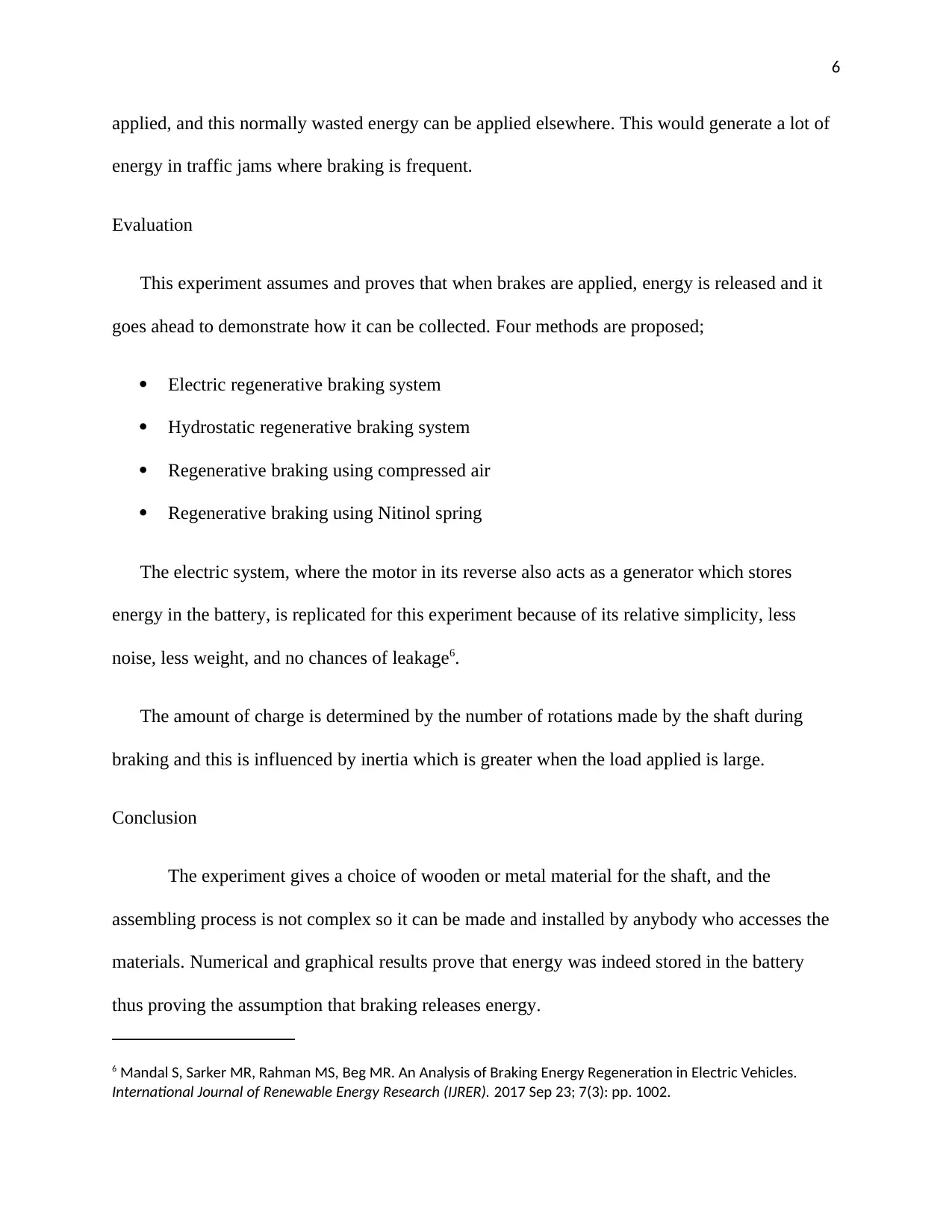
6
applied, and this normally wasted energy can be applied elsewhere. This would generate a lot of
energy in traffic jams where braking is frequent.
Evaluation
This experiment assumes and proves that when brakes are applied, energy is released and it
goes ahead to demonstrate how it can be collected. Four methods are proposed;
Electric regenerative braking system
Hydrostatic regenerative braking system
Regenerative braking using compressed air
Regenerative braking using Nitinol spring
The electric system, where the motor in its reverse also acts as a generator which stores
energy in the battery, is replicated for this experiment because of its relative simplicity, less
noise, less weight, and no chances of leakage6.
The amount of charge is determined by the number of rotations made by the shaft during
braking and this is influenced by inertia which is greater when the load applied is large.
Conclusion
The experiment gives a choice of wooden or metal material for the shaft, and the
assembling process is not complex so it can be made and installed by anybody who accesses the
materials. Numerical and graphical results prove that energy was indeed stored in the battery
thus proving the assumption that braking releases energy.
6 Mandal S, Sarker MR, Rahman MS, Beg MR. An Analysis of Braking Energy Regeneration in Electric Vehicles.
International Journal of Renewable Energy Research (IJRER). 2017 Sep 23; 7(3): pp. 1002.
applied, and this normally wasted energy can be applied elsewhere. This would generate a lot of
energy in traffic jams where braking is frequent.
Evaluation
This experiment assumes and proves that when brakes are applied, energy is released and it
goes ahead to demonstrate how it can be collected. Four methods are proposed;
Electric regenerative braking system
Hydrostatic regenerative braking system
Regenerative braking using compressed air
Regenerative braking using Nitinol spring
The electric system, where the motor in its reverse also acts as a generator which stores
energy in the battery, is replicated for this experiment because of its relative simplicity, less
noise, less weight, and no chances of leakage6.
The amount of charge is determined by the number of rotations made by the shaft during
braking and this is influenced by inertia which is greater when the load applied is large.
Conclusion
The experiment gives a choice of wooden or metal material for the shaft, and the
assembling process is not complex so it can be made and installed by anybody who accesses the
materials. Numerical and graphical results prove that energy was indeed stored in the battery
thus proving the assumption that braking releases energy.
6 Mandal S, Sarker MR, Rahman MS, Beg MR. An Analysis of Braking Energy Regeneration in Electric Vehicles.
International Journal of Renewable Energy Research (IJRER). 2017 Sep 23; 7(3): pp. 1002.
⊘ This is a preview!⊘
Do you want full access?
Subscribe today to unlock all pages.

Trusted by 1+ million students worldwide
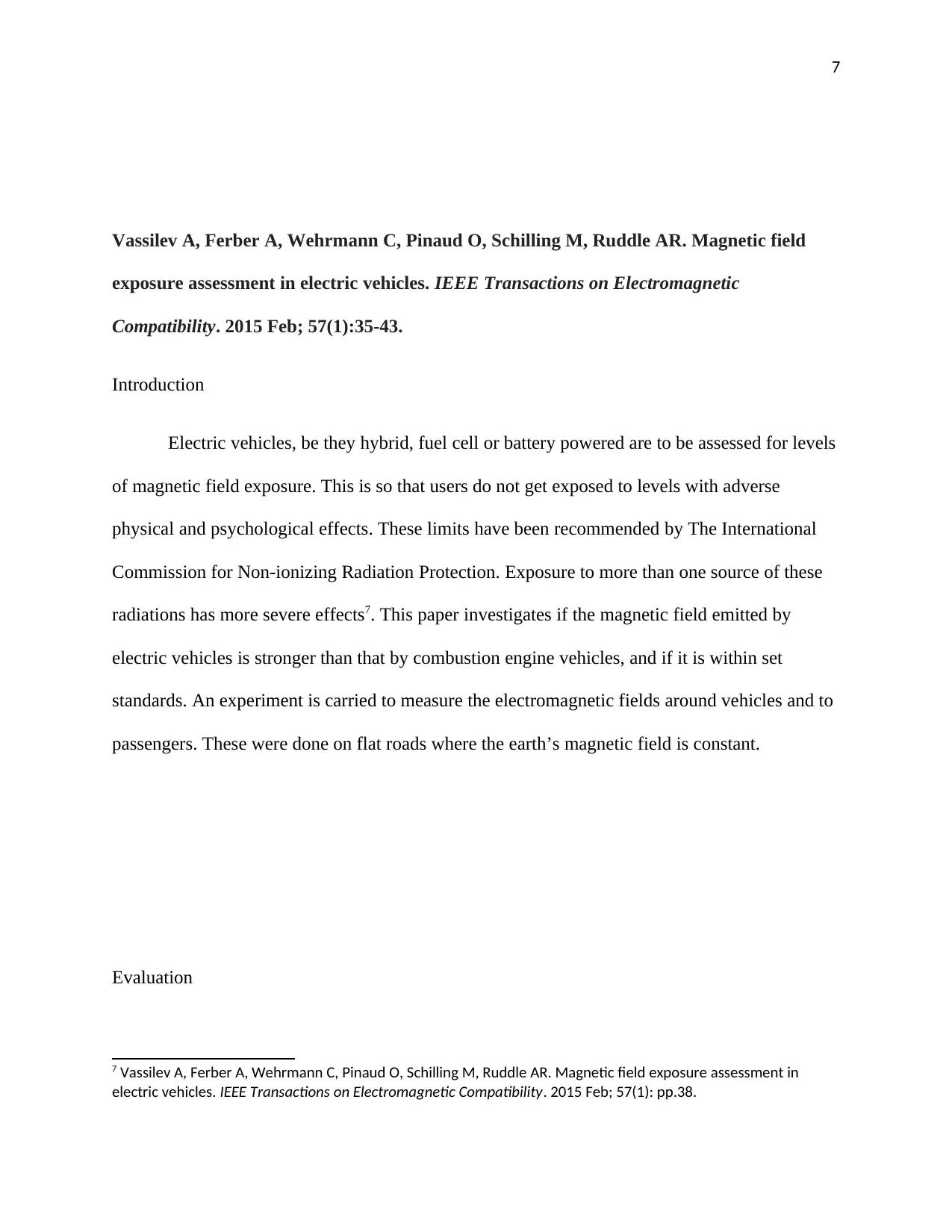
7
Vassilev A, Ferber A, Wehrmann C, Pinaud O, Schilling M, Ruddle AR. Magnetic field
exposure assessment in electric vehicles. IEEE Transactions on Electromagnetic
Compatibility. 2015 Feb; 57(1):35-43.
Introduction
Electric vehicles, be they hybrid, fuel cell or battery powered are to be assessed for levels
of magnetic field exposure. This is so that users do not get exposed to levels with adverse
physical and psychological effects. These limits have been recommended by The International
Commission for Non-ionizing Radiation Protection. Exposure to more than one source of these
radiations has more severe effects7. This paper investigates if the magnetic field emitted by
electric vehicles is stronger than that by combustion engine vehicles, and if it is within set
standards. An experiment is carried to measure the electromagnetic fields around vehicles and to
passengers. These were done on flat roads where the earth’s magnetic field is constant.
Evaluation
7 Vassilev A, Ferber A, Wehrmann C, Pinaud O, Schilling M, Ruddle AR. Magnetic field exposure assessment in
electric vehicles. IEEE Transactions on Electromagnetic Compatibility. 2015 Feb; 57(1): pp.38.
Vassilev A, Ferber A, Wehrmann C, Pinaud O, Schilling M, Ruddle AR. Magnetic field
exposure assessment in electric vehicles. IEEE Transactions on Electromagnetic
Compatibility. 2015 Feb; 57(1):35-43.
Introduction
Electric vehicles, be they hybrid, fuel cell or battery powered are to be assessed for levels
of magnetic field exposure. This is so that users do not get exposed to levels with adverse
physical and psychological effects. These limits have been recommended by The International
Commission for Non-ionizing Radiation Protection. Exposure to more than one source of these
radiations has more severe effects7. This paper investigates if the magnetic field emitted by
electric vehicles is stronger than that by combustion engine vehicles, and if it is within set
standards. An experiment is carried to measure the electromagnetic fields around vehicles and to
passengers. These were done on flat roads where the earth’s magnetic field is constant.
Evaluation
7 Vassilev A, Ferber A, Wehrmann C, Pinaud O, Schilling M, Ruddle AR. Magnetic field exposure assessment in
electric vehicles. IEEE Transactions on Electromagnetic Compatibility. 2015 Feb; 57(1): pp.38.
Paraphrase This Document
Need a fresh take? Get an instant paraphrase of this document with our AI Paraphraser
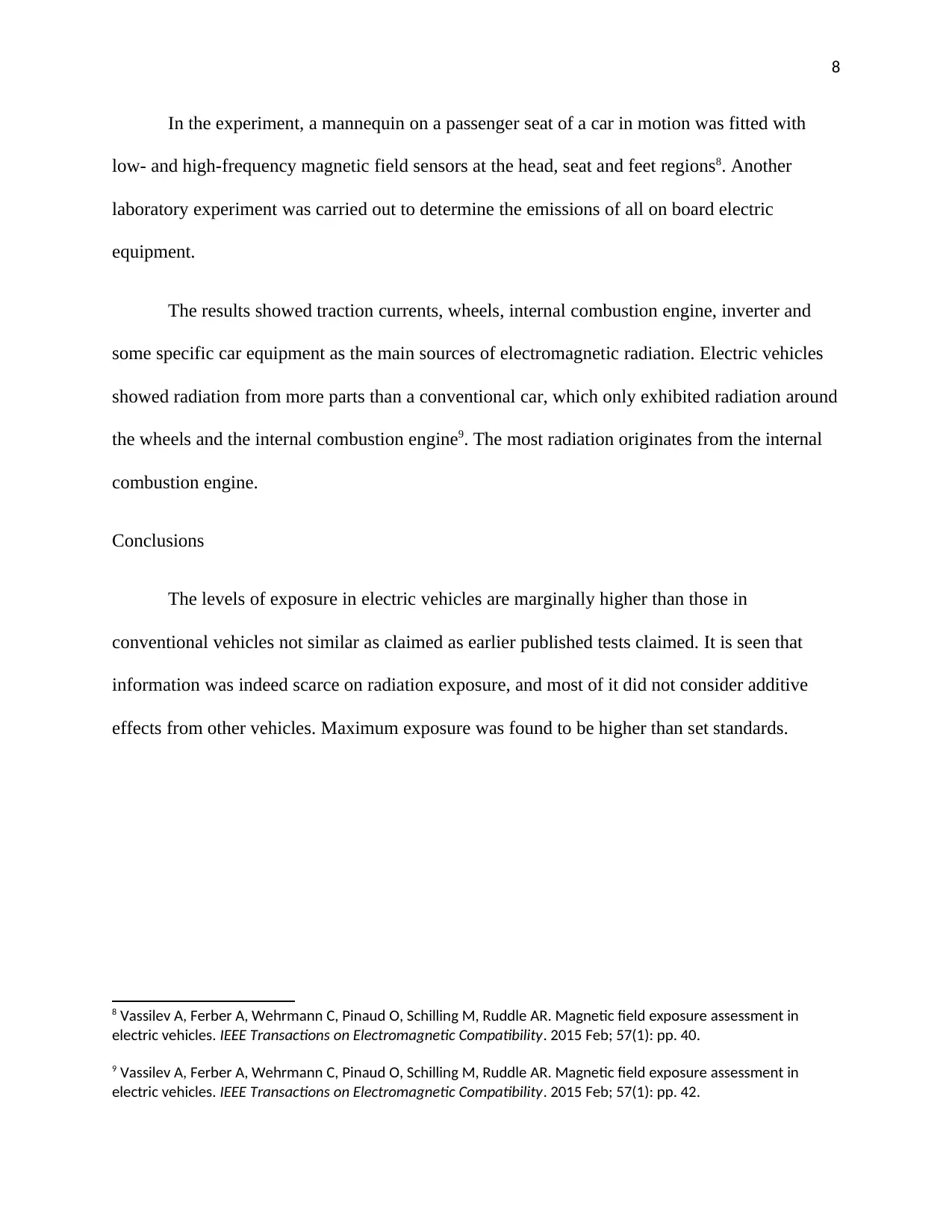
8
In the experiment, a mannequin on a passenger seat of a car in motion was fitted with
low- and high-frequency magnetic field sensors at the head, seat and feet regions8. Another
laboratory experiment was carried out to determine the emissions of all on board electric
equipment.
The results showed traction currents, wheels, internal combustion engine, inverter and
some specific car equipment as the main sources of electromagnetic radiation. Electric vehicles
showed radiation from more parts than a conventional car, which only exhibited radiation around
the wheels and the internal combustion engine9. The most radiation originates from the internal
combustion engine.
Conclusions
The levels of exposure in electric vehicles are marginally higher than those in
conventional vehicles not similar as claimed as earlier published tests claimed. It is seen that
information was indeed scarce on radiation exposure, and most of it did not consider additive
effects from other vehicles. Maximum exposure was found to be higher than set standards.
8 Vassilev A, Ferber A, Wehrmann C, Pinaud O, Schilling M, Ruddle AR. Magnetic field exposure assessment in
electric vehicles. IEEE Transactions on Electromagnetic Compatibility. 2015 Feb; 57(1): pp. 40.
9 Vassilev A, Ferber A, Wehrmann C, Pinaud O, Schilling M, Ruddle AR. Magnetic field exposure assessment in
electric vehicles. IEEE Transactions on Electromagnetic Compatibility. 2015 Feb; 57(1): pp. 42.
In the experiment, a mannequin on a passenger seat of a car in motion was fitted with
low- and high-frequency magnetic field sensors at the head, seat and feet regions8. Another
laboratory experiment was carried out to determine the emissions of all on board electric
equipment.
The results showed traction currents, wheels, internal combustion engine, inverter and
some specific car equipment as the main sources of electromagnetic radiation. Electric vehicles
showed radiation from more parts than a conventional car, which only exhibited radiation around
the wheels and the internal combustion engine9. The most radiation originates from the internal
combustion engine.
Conclusions
The levels of exposure in electric vehicles are marginally higher than those in
conventional vehicles not similar as claimed as earlier published tests claimed. It is seen that
information was indeed scarce on radiation exposure, and most of it did not consider additive
effects from other vehicles. Maximum exposure was found to be higher than set standards.
8 Vassilev A, Ferber A, Wehrmann C, Pinaud O, Schilling M, Ruddle AR. Magnetic field exposure assessment in
electric vehicles. IEEE Transactions on Electromagnetic Compatibility. 2015 Feb; 57(1): pp. 40.
9 Vassilev A, Ferber A, Wehrmann C, Pinaud O, Schilling M, Ruddle AR. Magnetic field exposure assessment in
electric vehicles. IEEE Transactions on Electromagnetic Compatibility. 2015 Feb; 57(1): pp. 42.
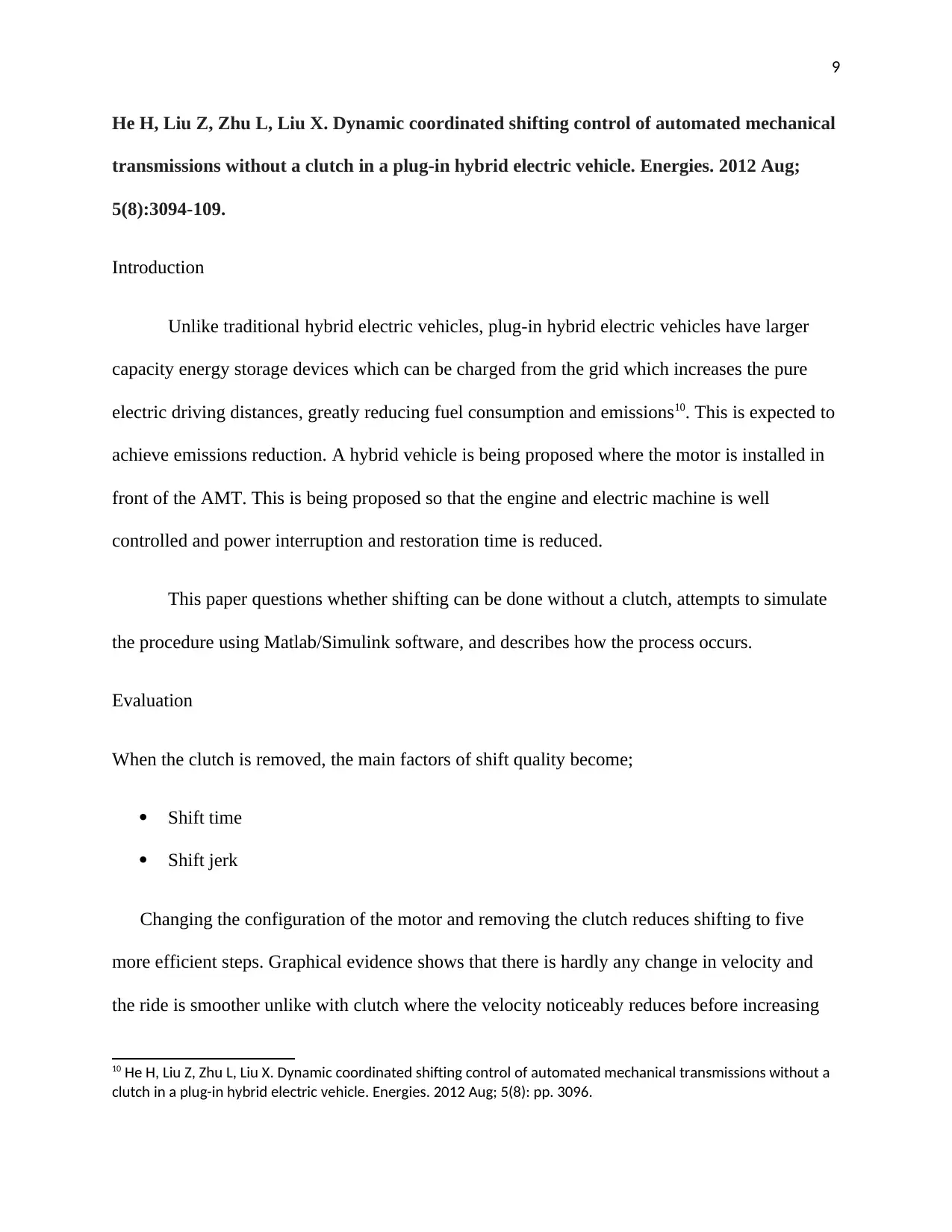
9
He H, Liu Z, Zhu L, Liu X. Dynamic coordinated shifting control of automated mechanical
transmissions without a clutch in a plug-in hybrid electric vehicle. Energies. 2012 Aug;
5(8):3094-109.
Introduction
Unlike traditional hybrid electric vehicles, plug-in hybrid electric vehicles have larger
capacity energy storage devices which can be charged from the grid which increases the pure
electric driving distances, greatly reducing fuel consumption and emissions10. This is expected to
achieve emissions reduction. A hybrid vehicle is being proposed where the motor is installed in
front of the AMT. This is being proposed so that the engine and electric machine is well
controlled and power interruption and restoration time is reduced.
This paper questions whether shifting can be done without a clutch, attempts to simulate
the procedure using Matlab/Simulink software, and describes how the process occurs.
Evaluation
When the clutch is removed, the main factors of shift quality become;
Shift time
Shift jerk
Changing the configuration of the motor and removing the clutch reduces shifting to five
more efficient steps. Graphical evidence shows that there is hardly any change in velocity and
the ride is smoother unlike with clutch where the velocity noticeably reduces before increasing
10 He H, Liu Z, Zhu L, Liu X. Dynamic coordinated shifting control of automated mechanical transmissions without a
clutch in a plug-in hybrid electric vehicle. Energies. 2012 Aug; 5(8): pp. 3096.
He H, Liu Z, Zhu L, Liu X. Dynamic coordinated shifting control of automated mechanical
transmissions without a clutch in a plug-in hybrid electric vehicle. Energies. 2012 Aug;
5(8):3094-109.
Introduction
Unlike traditional hybrid electric vehicles, plug-in hybrid electric vehicles have larger
capacity energy storage devices which can be charged from the grid which increases the pure
electric driving distances, greatly reducing fuel consumption and emissions10. This is expected to
achieve emissions reduction. A hybrid vehicle is being proposed where the motor is installed in
front of the AMT. This is being proposed so that the engine and electric machine is well
controlled and power interruption and restoration time is reduced.
This paper questions whether shifting can be done without a clutch, attempts to simulate
the procedure using Matlab/Simulink software, and describes how the process occurs.
Evaluation
When the clutch is removed, the main factors of shift quality become;
Shift time
Shift jerk
Changing the configuration of the motor and removing the clutch reduces shifting to five
more efficient steps. Graphical evidence shows that there is hardly any change in velocity and
the ride is smoother unlike with clutch where the velocity noticeably reduces before increasing
10 He H, Liu Z, Zhu L, Liu X. Dynamic coordinated shifting control of automated mechanical transmissions without a
clutch in a plug-in hybrid electric vehicle. Energies. 2012 Aug; 5(8): pp. 3096.
⊘ This is a preview!⊘
Do you want full access?
Subscribe today to unlock all pages.

Trusted by 1+ million students worldwide
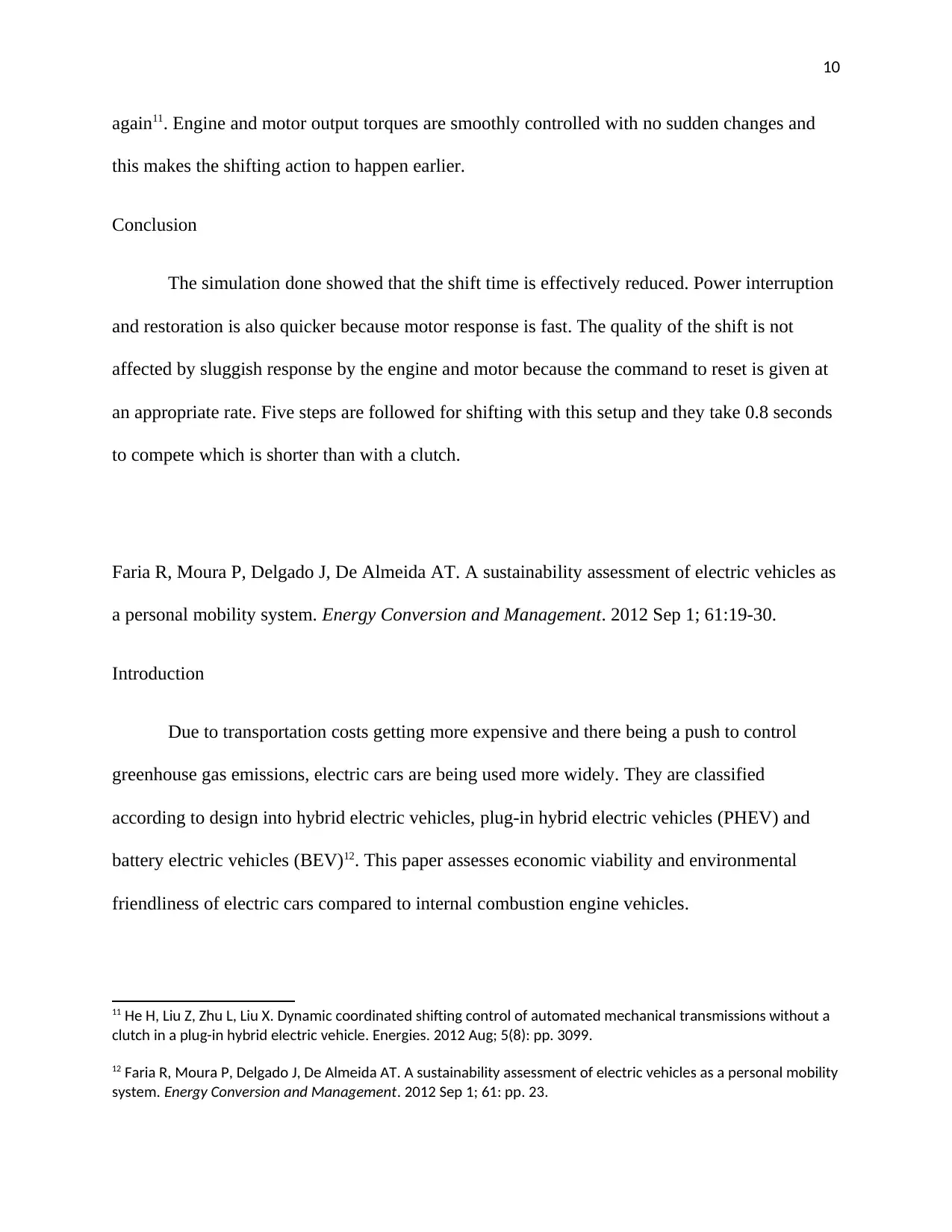
10
again11. Engine and motor output torques are smoothly controlled with no sudden changes and
this makes the shifting action to happen earlier.
Conclusion
The simulation done showed that the shift time is effectively reduced. Power interruption
and restoration is also quicker because motor response is fast. The quality of the shift is not
affected by sluggish response by the engine and motor because the command to reset is given at
an appropriate rate. Five steps are followed for shifting with this setup and they take 0.8 seconds
to compete which is shorter than with a clutch.
Faria R, Moura P, Delgado J, De Almeida AT. A sustainability assessment of electric vehicles as
a personal mobility system. Energy Conversion and Management. 2012 Sep 1; 61:19-30.
Introduction
Due to transportation costs getting more expensive and there being a push to control
greenhouse gas emissions, electric cars are being used more widely. They are classified
according to design into hybrid electric vehicles, plug-in hybrid electric vehicles (PHEV) and
battery electric vehicles (BEV)12. This paper assesses economic viability and environmental
friendliness of electric cars compared to internal combustion engine vehicles.
11 He H, Liu Z, Zhu L, Liu X. Dynamic coordinated shifting control of automated mechanical transmissions without a
clutch in a plug-in hybrid electric vehicle. Energies. 2012 Aug; 5(8): pp. 3099.
12 Faria R, Moura P, Delgado J, De Almeida AT. A sustainability assessment of electric vehicles as a personal mobility
system. Energy Conversion and Management. 2012 Sep 1; 61: pp. 23.
again11. Engine and motor output torques are smoothly controlled with no sudden changes and
this makes the shifting action to happen earlier.
Conclusion
The simulation done showed that the shift time is effectively reduced. Power interruption
and restoration is also quicker because motor response is fast. The quality of the shift is not
affected by sluggish response by the engine and motor because the command to reset is given at
an appropriate rate. Five steps are followed for shifting with this setup and they take 0.8 seconds
to compete which is shorter than with a clutch.
Faria R, Moura P, Delgado J, De Almeida AT. A sustainability assessment of electric vehicles as
a personal mobility system. Energy Conversion and Management. 2012 Sep 1; 61:19-30.
Introduction
Due to transportation costs getting more expensive and there being a push to control
greenhouse gas emissions, electric cars are being used more widely. They are classified
according to design into hybrid electric vehicles, plug-in hybrid electric vehicles (PHEV) and
battery electric vehicles (BEV)12. This paper assesses economic viability and environmental
friendliness of electric cars compared to internal combustion engine vehicles.
11 He H, Liu Z, Zhu L, Liu X. Dynamic coordinated shifting control of automated mechanical transmissions without a
clutch in a plug-in hybrid electric vehicle. Energies. 2012 Aug; 5(8): pp. 3099.
12 Faria R, Moura P, Delgado J, De Almeida AT. A sustainability assessment of electric vehicles as a personal mobility
system. Energy Conversion and Management. 2012 Sep 1; 61: pp. 23.
Paraphrase This Document
Need a fresh take? Get an instant paraphrase of this document with our AI Paraphraser
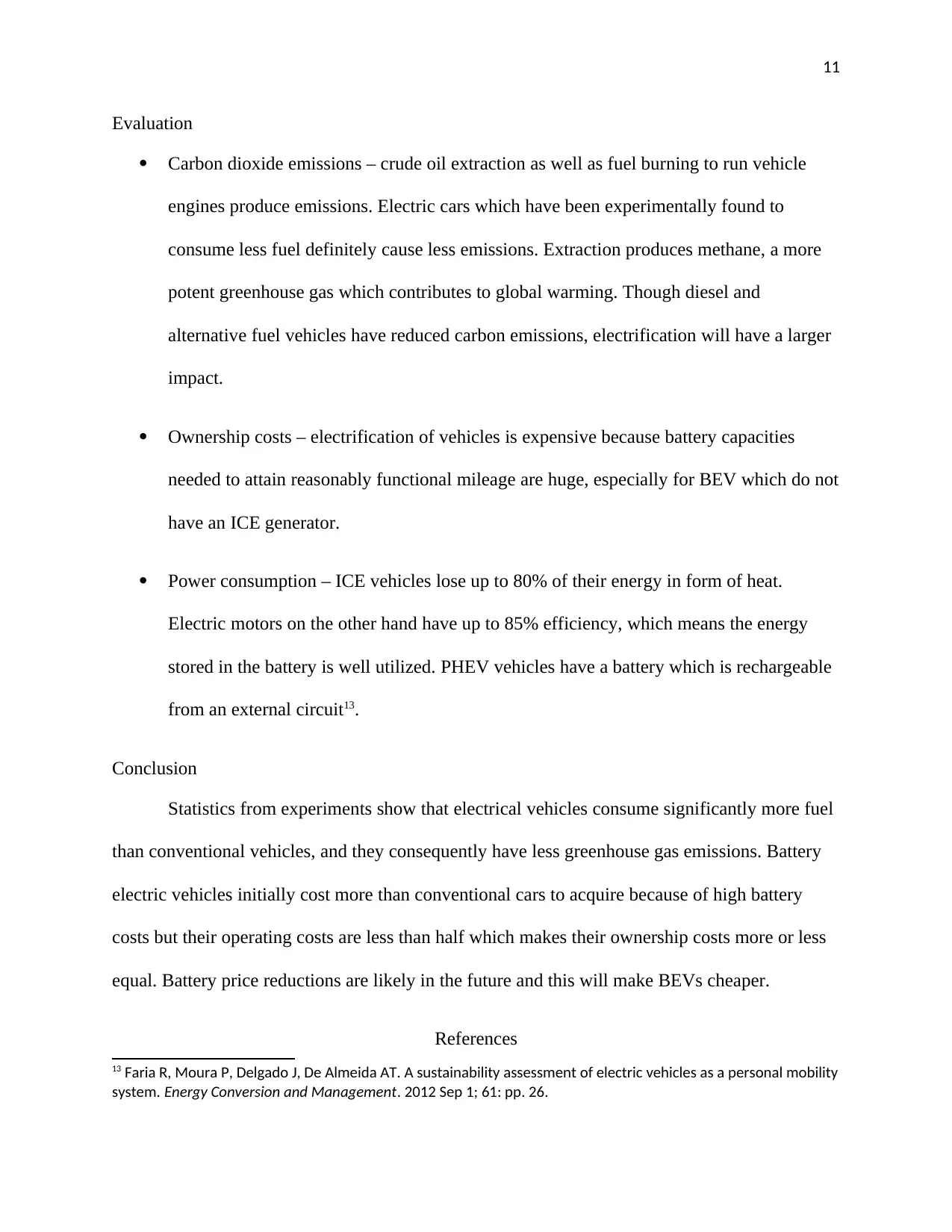
11
Evaluation
Carbon dioxide emissions – crude oil extraction as well as fuel burning to run vehicle
engines produce emissions. Electric cars which have been experimentally found to
consume less fuel definitely cause less emissions. Extraction produces methane, a more
potent greenhouse gas which contributes to global warming. Though diesel and
alternative fuel vehicles have reduced carbon emissions, electrification will have a larger
impact.
Ownership costs – electrification of vehicles is expensive because battery capacities
needed to attain reasonably functional mileage are huge, especially for BEV which do not
have an ICE generator.
Power consumption – ICE vehicles lose up to 80% of their energy in form of heat.
Electric motors on the other hand have up to 85% efficiency, which means the energy
stored in the battery is well utilized. PHEV vehicles have a battery which is rechargeable
from an external circuit13.
Conclusion
Statistics from experiments show that electrical vehicles consume significantly more fuel
than conventional vehicles, and they consequently have less greenhouse gas emissions. Battery
electric vehicles initially cost more than conventional cars to acquire because of high battery
costs but their operating costs are less than half which makes their ownership costs more or less
equal. Battery price reductions are likely in the future and this will make BEVs cheaper.
References
13 Faria R, Moura P, Delgado J, De Almeida AT. A sustainability assessment of electric vehicles as a personal mobility
system. Energy Conversion and Management. 2012 Sep 1; 61: pp. 26.
Evaluation
Carbon dioxide emissions – crude oil extraction as well as fuel burning to run vehicle
engines produce emissions. Electric cars which have been experimentally found to
consume less fuel definitely cause less emissions. Extraction produces methane, a more
potent greenhouse gas which contributes to global warming. Though diesel and
alternative fuel vehicles have reduced carbon emissions, electrification will have a larger
impact.
Ownership costs – electrification of vehicles is expensive because battery capacities
needed to attain reasonably functional mileage are huge, especially for BEV which do not
have an ICE generator.
Power consumption – ICE vehicles lose up to 80% of their energy in form of heat.
Electric motors on the other hand have up to 85% efficiency, which means the energy
stored in the battery is well utilized. PHEV vehicles have a battery which is rechargeable
from an external circuit13.
Conclusion
Statistics from experiments show that electrical vehicles consume significantly more fuel
than conventional vehicles, and they consequently have less greenhouse gas emissions. Battery
electric vehicles initially cost more than conventional cars to acquire because of high battery
costs but their operating costs are less than half which makes their ownership costs more or less
equal. Battery price reductions are likely in the future and this will make BEVs cheaper.
References
13 Faria R, Moura P, Delgado J, De Almeida AT. A sustainability assessment of electric vehicles as a personal mobility
system. Energy Conversion and Management. 2012 Sep 1; 61: pp. 26.

12
Faria R, Moura P, Delgado J, De Almeida AT. A sustainability assessment of electric vehicles as
a personal mobility system. Energy Conversion and Management. 2012 Sep 1; 61:19-30.
He H, Liu Z, Zhu L, Liu X. Dynamic coordinated shifting control of automated mechanical
transmissions without a clutch in a plug-in hybrid electric vehicle. Energies. 2012 Aug;
5(8):3094-109.
Mandal S, Sarker MR, Rahman MS, Beg MR. An Analysis of Braking Energy Regeneration in
Electric Vehicles. International Journal of Renewable Energy Research (IJRER). 2017 Sep 23;
7(3):999-1006.
Propfe B, Redelbach M, Santini D, Friedrich H. Cost analysis of plug-in hybrid electric vehicles
including maintenance & repair costs and resale values. World Electric Vehicle Journal. 2012
Dec; 5(4):886-95.
Silva F, Aragón M. Electromagnetic interferences from electric/hybrid vehicles. In 2011 XXXth
URSI General Assembly and Scientific Symposium 2011 Aug 13 (pp. 1-4).
Vassilev A, Ferber A, Wehrmann C, Pinaud O, Schilling M, Ruddle AR. Magnetic field
exposure assessment in electric vehicles. IEEE Transactions on Electromagnetic Compatibility.
2015 Feb; 57(1):35-43.
Faria R, Moura P, Delgado J, De Almeida AT. A sustainability assessment of electric vehicles as
a personal mobility system. Energy Conversion and Management. 2012 Sep 1; 61:19-30.
He H, Liu Z, Zhu L, Liu X. Dynamic coordinated shifting control of automated mechanical
transmissions without a clutch in a plug-in hybrid electric vehicle. Energies. 2012 Aug;
5(8):3094-109.
Mandal S, Sarker MR, Rahman MS, Beg MR. An Analysis of Braking Energy Regeneration in
Electric Vehicles. International Journal of Renewable Energy Research (IJRER). 2017 Sep 23;
7(3):999-1006.
Propfe B, Redelbach M, Santini D, Friedrich H. Cost analysis of plug-in hybrid electric vehicles
including maintenance & repair costs and resale values. World Electric Vehicle Journal. 2012
Dec; 5(4):886-95.
Silva F, Aragón M. Electromagnetic interferences from electric/hybrid vehicles. In 2011 XXXth
URSI General Assembly and Scientific Symposium 2011 Aug 13 (pp. 1-4).
Vassilev A, Ferber A, Wehrmann C, Pinaud O, Schilling M, Ruddle AR. Magnetic field
exposure assessment in electric vehicles. IEEE Transactions on Electromagnetic Compatibility.
2015 Feb; 57(1):35-43.
⊘ This is a preview!⊘
Do you want full access?
Subscribe today to unlock all pages.

Trusted by 1+ million students worldwide
1 out of 12
Your All-in-One AI-Powered Toolkit for Academic Success.
+13062052269
info@desklib.com
Available 24*7 on WhatsApp / Email
![[object Object]](/_next/static/media/star-bottom.7253800d.svg)
Unlock your academic potential
Copyright © 2020–2026 A2Z Services. All Rights Reserved. Developed and managed by ZUCOL.


